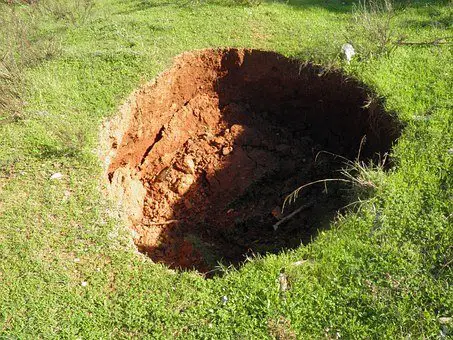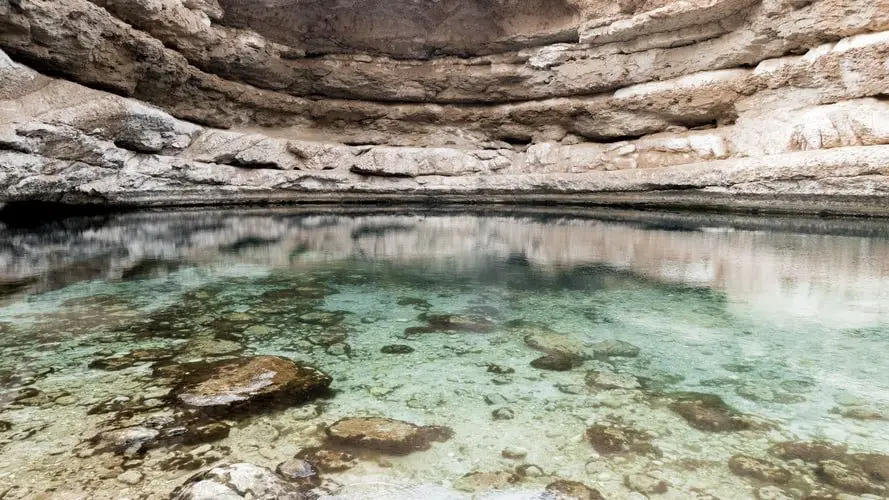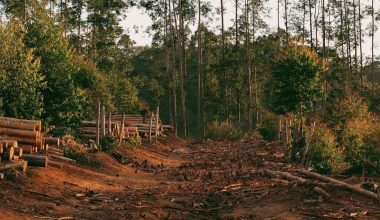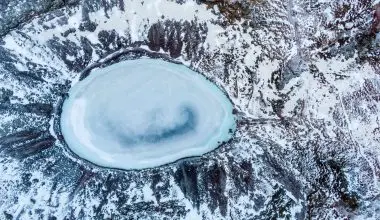Table of Contents Show
What are Sinkholes?
Sinkholes are underground bedrocks that have collapsed leaving behind a large hole that may vary in size. The sinkholes may be from 3 feet wide to about 2000 feet wide. They are found throughout the world and can occur due to natural processes or because of human intervention such as the cutting down of trees or leaving behind large construction debris. In addition to leaving large holes, they may also pollute the underground water sources.
Here we will look at the causes of how a sinkhole is formed and also look at ways in which we can fix a sinkhole.
How are sinkholes formed?
Sinkholes typically occur in terrains known as Karst terrain. In Karst terrain, the rocks located both on the surface or underground are susceptible to erosion both by natural running water or water from rainfall. These rocks include gypsum, limestone, and domes which can easily be eroded.
When there is run off of water or torrential rainfall in these types of terrain, the soluble rocks underneath the surface start dissolving, thereby creating spaces and large caverns. As time progresses, these spaces become larger while the surface remains normal and intact. This process may take years and years until the ground above is no longer supported by the eroded rocks below leading to the sudden collapse of the surface and eventual formation of a sinkhole.
Sometimes sinkholes may occur more quickly due to massive rainfall and drought seasons which can either cause quick dissolving of the rock or may cause the water underneath to be lost leaving behind space creating massive sinkholes in the process. As there is increasing climate change in the world leading to ever-changing weather conditions throughout the planet, the risks of the development of sinkholes are increasing more and more.
Types of Sinkholes
There are four types of sinkholes classified by geologists which are:
1. Dissolution Sinkholes
A dissolution sinkhole is a type of sinkhole in which a solute becomes dissolved in essentially a solvent just like any solution. Dissolution sinkholes start when soluble rocks such as dolomite or limestone which are close to the surface and covered by soil start dissolving slowly leading to the formation of a depression which eventually converts into a sinkhole. This process varies according to the amount of water falling on the rocks and the rate at which the water is flowing through the rocks.
2. Cover-Subsidence Sinkholes
These types of sinkholes occur when unconsolidated materials such as sand cover the soluble rocks. Over time, water will dissolve the soluble rocks creating voids and spaces which will be filled with sand. The sand will help to obstruct the outflow of water preventing the passage of water from the garden and soon water will have no way to flow or drain into the ground. These sinkholes may eventually convert into small underground ponds. The depth and width of these sinkholes are not that great either as compared to other types of sinkholes.
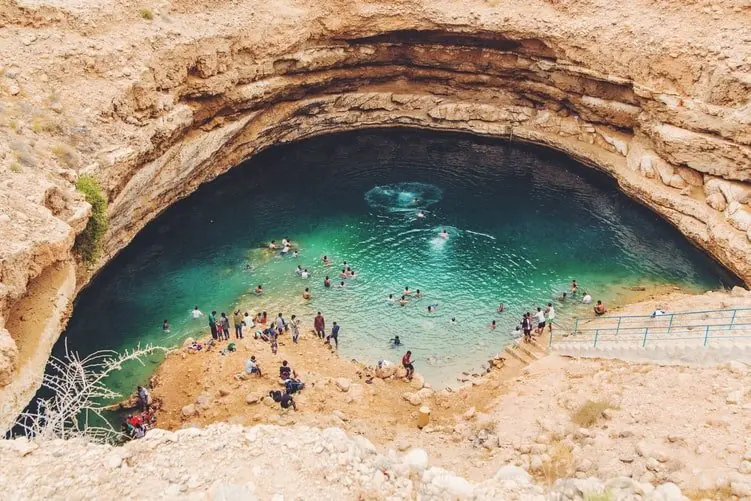
A similar example in United States shown below, Find out!
3. Cover-Collapse Sinkholes
These types of sinkholes can be the most catastrophic of the sinkholes. The reason why they are so alarming and dangerous is that they may occur suddenly, swallowing many cars or houses as the land is no longer supported by the matter below leading to the total collapse of the surface spontaneously. These types of sinkholes are formed when the groundwater or rainwater slowly starts dissolving the soluble rocks such as limestone which are covered by the soil, thereby creating spaces underground. Soon these spaces become enormous up to the extent that they can no longer support the weight of the land on top giving way to sinkholes.
4. Artificial Sinkholes
The previously mentioned sinkholes were all created through various natural processes that involved the dissolution and erosion of the soluble rock below the surface by water through various sources. However, artificial sinkholes are a man-made phenomenon and occur due to various reasons such as leaky faucets, old mines, sewers, and water lines, drilling, groundwater pumping and during construction.
Detection of Sinkholes; How to find them?
It is not always easy to predict if you live near or even on a sinkhole or not. If you are curious or think that there may be a sinkhole near you; it is necessary to inform your local or state government about them. Various geological surveys and geologists from The United States Geological Survey (or others) are constantly on the lookout for any potential sinkholes that may be present.
Geologists are constantly on the lookout for underground cavities that may potentially develop into sinkholes. Various instruments are used by these scientists to detect sinkholes such as seismographs, radars, and electrical resistance.
There are potential signs that you can be aware of that may help to detect future sinkholes. These include the collection of water in areas where there shouldn’t be any water collection, small holes in the grounds, the slumping of trees and fences or the wilting of small areas of vegetation.
If you detect a potential sinkhole that may develop or find a sinkhole in your neighborhood or on the middle of the road be sure to immediately contact your local emergency departments and evacuate and stay away from the area until the concerned professionals say it’s safe to come near.
How to Fix a Sinkhole in your Backyard? Best Solutions
It is very difficult to fix a large-sized sinkhole as they will require excavation and more complex filling operations. However, a sinkhole that is 2-5 feet wide and deep is usually repaired single-handedly.
Here are the steps on How to fix a sinkhole. This process is also known as the Graded-Filter technique.
- Use a stick or any other equipment that helps you to measure the actual depth of the sinkhole. It is also necessary that the base of the sinkhole is even and stable so that we may be aware of a potential collapse of the sinkhole. The sinkhole must be checked if it is not growing in depth hence measurement of the depth of the sinkhole must be taken into account on more than one occasion (a day apart).
- The next step requires the removal of the outer edges of the sinkhole if they are potentially unstable using a shovel.
- The next step requires the building of a solid base of the sinkhole so that we may prevent it from growing more in-depth and also preventing the future collapse of the sinkhole by giving it more stability. This is done by adding a dry mix of concrete or a concrete plug in the base of the sinkhole. The concrete should be strong and should have a good consistency upon setting so that it may form a solid stable base for the sinkhole.
- Clay-like sand is then added on top of the concrete. The purpose of this is to prevent the leakage of water through potential pores which may eventually cause the sinkhole to increase in size over time. If clayey sand is not available, normal sand may also do the job whereas even rocks can be used to fill the sinkhole once the base has been properly stabilized.
- The addition of sand and topsoil should be done now on top of the previous layers of sand so that all of the components may blend. The soil should be packed thoroughly using either a hammer or an iron bar. Hammering will also be creating a flat surface in the process.
- The last step is the addition of water. Water helps the filling material to settle down thoroughly and also gives you an indication if more soil is required or not.
And that’s it! You have successfully fixed your sinkhole without breaking a sweat (not exactly).
Large sinkholes, sadly, cannot be fixed alone and require a lot of skilled manpower and engineers to fix these massive cavities according to the required environmental conditions.
Sometimes blocks of cement and rocks may be used to fix these large sinkholes. This may be potentially dangerous as water may divert and gather in areas filled with cement adjacent to the sinkhole and potentially cause the development of further sinkholes, or enlargement of the same one.
The large sinkholes should also be fixed using the graded-filter technique which was previously mentioned for fixing small sinkholes.
The advantage of using this technique is that it prevents the concentration of water underground which is the reason why most of the sinkholes develop in the first place. The graded-filter technique allows the passage of water out of these areas preventing the accumulation of the water underground.
The sinkhole is constantly connected to aquifers. Hence, when a sinkhole is being fixed, they should not be filled with materials that can inadvertently cause the contamination of these nearby aquifers.
5+ Major Examples of Sinkholes in the United States
1. Daisetta, Texas
Several sinkholes have been formed in Daisetta, Texas; 14 great sinkholes to be exact! The most recent one was discovered in 2008 as large as 620 ft (190 m) in diameter with a depth of more than 150 ft (46 m)!
2. Devil’s Millhopper Sinkhole, Florida
The Devil’s Millhopper sinkhole in Gainesville, Florida is more than 100 ft deep (37 m) and 500 ft wide (150 m). It was formed by dissolution of limestone rock by the acidic groundwater over an extended period of time.
Countless fossil deposits rest at the bottom of Devil’s Millhopper including shark remains, marine shells and remains of other extinct terrestrial animals.
3. Bayou Corne Sinkhole – Assumption Louisiana, Texas
The Bayou Corne Sinkhole, located in Northern Assumption Louisiana, Texas is around 25 acres in area and more than 750 ft (230 meters) in depth. Bayou Corne sinkhole was first discovered in 2012 when residents started to notice shaking of ground and bubbles emerging in lakes. This led to the evacuation of 350 residents!
The sinkhole was created when an underground cavern full of salt, operated by Texas Brine company and owned by Occidental Petroleum, collapsed. Scientists believe the evacuation could last for years and the town may be left deserted forever.
4. Gypsum Hole – Utah
Gypsum sinkhole is located in the Capitol Reef National Park in Utah. It’s relatively small, but nonetheless, around 15 meters (50 ft) in diameter and 4 times that in depth (60 m or 200 ft).
5. Winter Park Sinkhole
The Winter Park Sinkhole is present in Central Florida was first discovered in May 1981. More than a 100 m (350 ft) in diameter and 23 meters (75 ft) deep! At the time, it was considered one of the largest sinkholes to form in the United States!
6. The Blue Hole
The Blue Hole is located in Santa Rosa, New Mexico which seems small in appearance with the entrance of the sinkhole being only 80 ft in diameter. However, The Blue Hole expands as you go deeper to a diameter of 130 ft (40m) at the bottom!
